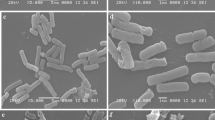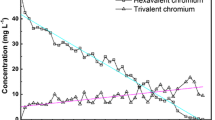Abstract
We have studied the reduction of hexavalent chromium (chromate) to the less toxic trivalent form by using cell suspensions and cell-free extracts from the common soil bacterium, Bacillus subtilis. B. subtilis was able to grow and reduce chromate at concentrations ranging from 0.1 to 1 mM K2CrO4. Chromate reduction was not affected by a 20-fold excess of nitrate-compound that serves as alternate electron acceptor and antagonizes chromate reduction by anaerobic bacteria. Metabolic poisons including sodium azide and sodium cyanide inhibited chromate reduction. Reduction was effected by a constitutive system associated with the soluble protein fraction and not with the membrane fraction. The reducing activity was heat labile and showed a Km of 188 μm CrO4 2-. The reductase can mediate the transfer of electrons from NAD(P)H to chromate. The results suggest that chromate is reduced via a detoxification system rather than dissimilatory electron transport.
Similar content being viewed by others
References
Arslan P, Beltrame M & Tomasi A (1987) Intracellular chromium reduction. Biochimica et Biophysica Acta 931: 10- 15
Bell CF & Lott KAK (1966) Modern Approach to Inorganic Chemistry, 2nd edn. Butterworth & Co., London
Bopp LH & Ehrlich HL (1988) Chromate resistance and reduction in Pseudomonas fluorescens strain LB300. Archives of Microbiology 150: 426- 431
Cervantes C (1991) Bacterial interactions with chromate. Antonie van Leeuwenhoek 59: 229- 233
Efstathiou JD & McKay LL (1977) Inorganic salts resistance associated with a lactose-fermenting plasmid in Staphylococcus lactis. Journal of Bacteriology 130: 257- 265
Greenberg AE, Connors JL, Jenkins D & Franson MAH (1981) Standard Methods for the Examination of Water and Wastewater, 15th edn. American Public Health Association, Washington, D.C
Gvozdyak PI, Mogilevich NF, Rylśkii AF & Grishchenko NI (1986) Reduction of hexavalent chromium by collection strains of bacteria. Mikrobiologiya 55: 962- 965
Horitsu H, Futo S, Miyazawa Y, Ogai S & Kawai K (1987) Enzymatic reduction of hexavalent chromium by hexavalent chromium tolerant Pseudomonas ambigua G-1. Agricultural and Biological Chemistry 51: 2417- 2420
Ishibashi Y, Cervantes C & Silver S (1990) Chromium reduction in Pseudomonas putida. Applied and Environmental Microbiology 56: 2268- 2270
Komori KP, Wang PC, Toda T & Ohtake H (1989) Factors affecting chromate reduction in Enterobacter cloacae strain HO1. Applied Microbiology and Biotechnology 31: 567- 570
Komori K, Rivas A, Toda K & Ohtake H (1990) Biological removal of toxic chromium using an Enterobacter cloacae strain that reduces chromate under anaerobic conditions. Biotechnology and Bioengineering 35: 951- 954
Kvasnikov EI, Stepanyuk VV, Klushnikova TM, Serpokrylov NS, Simonova GA, Kasatkina TP & Panchenko LP (1985) A new chromium-reducing gram variable bacterium with myxed type of flagellation. Mikrobiologiya 54: 83- 88
Lebedeva EV & Lyalikova NN (1979) Reduction of crocoite by Pseudomonas chromatophila sp. nov. Mikrobiologiya 48: 517- 522
Luli GW, Talnagi JW, Strohl WR & Pfister RM (1983) Hexavalent chromiun-resistant bacteria isolated from river sediments. Applied and Environmental Microbiology 46: 846- 854
Novic RP & Roth C (1968) Plasmid-linked resistance to inorganic salts in Staphylococcus aureus. Journal of Bacteriology 95: 1335- 1342
Ohtake H, Fujii E & Toda K (1990a) Reduction of toxic chromate in an industrial effluent by use of a chromate-reducing strain of Enterobacter cloacae. Environmental Technology 11: 663- 668
Ohtake H, Fujii E & Toda K (1990b) Bacterial reduction of hexavalent chromium: kinetic aspects of chromate reduction by Enterobacter cloacae HO1. Biocatalysis 4: 227- 235
Peterson GL (1977) A simplification of the protein assay method of Lowry et al. which is more generally applicable. Analytical Biochemistry 83: 346- 356
Petrilli FL & De Flora S (1977) Toxicity and mutagenicity of hexavalent chromium on Salmonella typhimurium. Applied and Environmental Microbiology 33: 805- 809
Romanenko VI & Koren'kov VN (1977) A pure culture of bacteria utilizing chromates and bichromates as hydrogen acceptors in growth under anaerobic conditions. Mikrobiologiya 46: 414- 417
Suzuki T, Miyata N, Horitsu H, Kawai K, Takamizawa K, Tai Y & Okazaki M (1992) NAD(P)H-dependent chromium(VI) reductase of Pseudomonas ambigua G-1: a Cr(V) intermediate is formed during the reduction of Cr(VI) to Cr(III). Journal of Bacteriology 174: 5340- 5345
Wang P-C, Mori T, Komori K, Sasatsu M, Toda K & Ohtake H (1989) Isolation and characterization of an Enterobacter cloacae strain that reduces hexavalent chromium under anaerobic conditions. Applied and Environmental Microbiology 55: 1665- 1669
Wang P-C, Mori T, Toda K & Ohtake H (1990) Membrane-associated chromate reductase activity from Enterobacter cloacae. Journal of Bacteriology 172: 1670- 1672
Wang P-C, Toda K, Ohtake H, Kusaka I & Yabe I (1991) Membrane-bound respiratory system of Enterobacter cloacae strain HO1 grown anaerobically with chromate. FEMS Microbiology Letters 78: 11- 16
Rights and permissions
About this article
Cite this article
Garbisu, C., Alkorta, I., Llama, M.J. et al. Aerobic chromate reduction by Bacillus subtilis. Biodegradation 9, 133–141 (1998). https://doi.org/10.1023/A:1008358816529
Issue Date:
DOI: https://doi.org/10.1023/A:1008358816529




